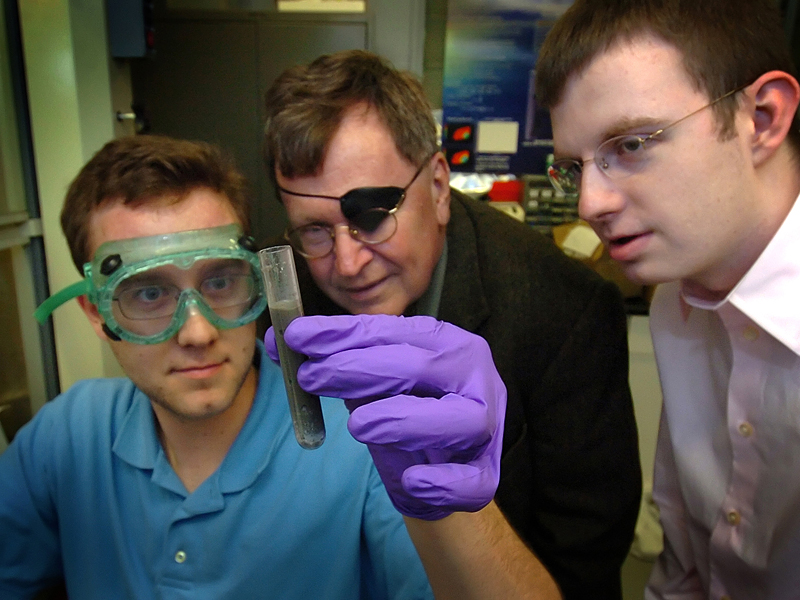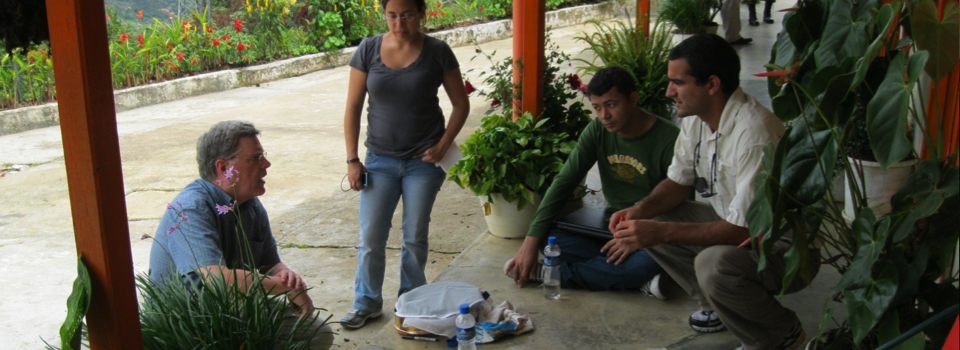Researchers look to deliver water (and energy) in ways both old and new
Researchers look to deliver water (and energy) in ways both old and new
| Author: | William Meiners and Emil Venere |
|---|---|
| Magazine Section: | Change The World |
| College or School: | CoE |
| Article Type: | Issue Feature |
| Page CSS: | .sidebar.right {
top: -1200px; } |
Chad Jafvert, professor of civil engineering, stepped outside his normal zone of research to collaborate with students in the Global Engineering Program (GEP). The group’s semester project resulted in a real-world solution and better drinking water for schoolchildren in rural Colombia.
On the flip, or perhaps futuristic, side, Jerry Woodall, the Barry M. and Patricia L. Epstein Distinguished Professor of Electrical and Computer Engineering, has led research in the development of an aluminum alloy that could be used in a new type of mobile technology to convert nonpotable water into drinking water while also extracting hydrogen to generate electricity.
Global delivery
Kimberly-Clark Corp. sponsored the fall 2010 GEP project, which turned the attention of Purdue engineers to the very real need for clean drinking water in remote parts of the world. The company operates paper production facilities in South America, including a plant near Barbosa, Colombia. Company officials wanted to improve water quality for area residents, many of whom are employees.
Untreated water from nearby streams is piped to elementary schools and homes in the villages of Las Peas, Buga and Graciano, which are accessible by narrow roads leading from Barbosa. The water contains particles and pathogens from sources such as dead leaves and cow manure.
Students on the Global Design Team determined that one of the most affordable and easy-to-maintain filtration methods for the communities is slow-sand filtration, which uses layers of sand and gravel to clean water. However, existing slow-sand filtering systems were too bulky and expensive for the communities, Jafvert says.
“We needed something lower cost for very rural areas where people are living with few resources,” he says.
Jafvert and the students created a new type of slow-sand filter contained in two five-gallon plastic buckets. Water is poured in the top bucket and emerges clear from the bottom bucket but still requires boiling before drinking.
“We created a design that’s simple, portable and easy to clean,” says Jafvert of the elegant solution he describes as “low-tech.”
The team of Purdue students installed the new drinking water filtration systems at three elementary schools, one in each of the communities. About 20 children attend each school.
The project began last fall with a course developed through the Global Engineering Program and will be offered again by the GEP in cooperation with the College of Engineering’s Division of Environmental and Ecological Engineering. Nine students in the class came from a range of disciplines, including civil engineering and agricultural and biological engineering.
“The project made me feel like I was contributing to a greater good because what we designed went into schools and communities where there is a serious water shortage problem,” says Craig B. Collins, a civil engineering senior. “We were able to not only do the research but also build the filters. The team had talented students from different majors and different cultures. I feel I want to work on similar projects in the future to help improve the quality of life for people in developing regions.”
The systems, which are capable of filtering 20 liters per day, cost about $43.
“We could probably bring that down even further, to $25 or $30,” Jafvert says. “You pour 20 liters in and you collect 20 liters, and you do the same thing the next day. The sand must be the right size. It’s not so fine that the flow rate is inhibited, and it provides a huge surface area for bacteria to attach to.”
The system behaves like a miniature aquifer because it slowly cleans the water.
“The water flow is slow enough that bacteria attached to sand grains can metabolize organic contaminants,” Jafvert says. “You have good and bad bacteria. The good bacteria help to remove the dissolved organic contaminants. Pathogens in manure or human waste are removed by attachment to the large surface area of the sand.”
Students worked on the project in a one-semester, three-credit course, but the project will continue in the fall semester with new students. Next semester civil engineering professor Loring Nies will join the GEP Colombia team. He and Jafvert may pursue improvements, including the replacement of the bottom gravel layers.
“It would be much easier if we had a porous plate on the bottom,” Jafvert says. “Otherwise, you spend lot of time sieving material to create the layers.”
Even though the filters clean the water, it still has to be boiled to kill remaining bacteria. However, Jafvert envisions future designs that use filtration cartridges or chlorine bleach to remove bacteria instead of boiling. He also is looking into future designs for a larger system capable of providing clear water for a whole community.
The Global Engineering Program was critical in creating the project and has similar design teams working on projects in Cameroon, Kenya, Jordan, Lebanon and Palestine.
Aluminum possibilities
Woodall has long been looking into the resource possibilities of aluminum, one of the most abundant metals on Earth. He believes his aluminum alloy makes great economic sense as well.
The alloy contains aluminum, gallium, indium and tin. Immersing the alloy in freshwater or saltwater causes a spontaneous reaction, turning the water into steam and generating hydrogen and aluminum tri-hydroxide until the aluminum is used up. The hydrogen then could be fed to a fuel cell to generate electricity, producing potable water.

A video describing how the hydrogen-producing technology works is available online at http://hydrogen.ecn.purdue.edu.
“The steam would kill any bacteria contained in the water, and then it would condense to purified water,” Woodall says. “So, you are converting undrinkable water to drinking water.”
Because the technology works with saltwater, it might have marine applications, such as powering boats and robotic underwater vehicles. The technology also might be used to desalinate water, says Woodall, who is working with doctoral student Go Choi.
A patent on the design is pending.
Woodall envisions a new portable technology for regions that aren’t connected to a power grid, such as villages in Africa and other remote areas.
“There is a big need for this sort of technology in places lacking connectivity to a power grid and where potable water is in short supply,” he says. “Because aluminum is a low-cost, nonhazardous metal that is the third most abundant metal on Earth, this technology promises to enable a global-scale potable water and power technology, especially for off-grid and remote locations.”
The potable water could be produced for about $1 per gallon, and electricity could be generated for about 35 cents per kilowatt hour of energy.
“There is no other technology to compare it against, economically, but it’s obvious that 35 cents per kilowatt hour is cheap compared to building a power plant and installing power lines, especially in remote areas,” Woodall says.
The unit, including the alloy, the reactor and fuel cell might weigh less than 100 pounds.
“You could drop the alloy, a small reaction vessel and a fuel cell into a remote area via parachute,” Woodall says. “Then the reactor could be assembled along with the fuel cell. The polluted water or the seawater would be added to the reactor and the reaction converts the aluminum and water into aluminum hydroxide, heat and hydrogen gas on demand.”
The aluminum hydroxide waste is nontoxic and could be disposed of in a landfill. The researchers have a design but haven’t built a prototype.

Comments